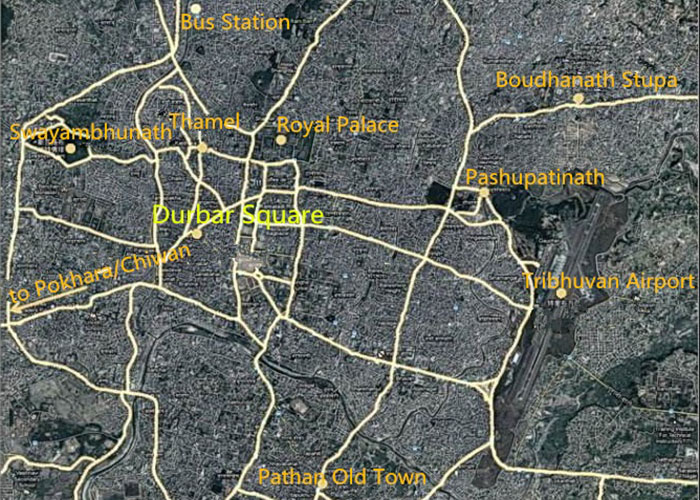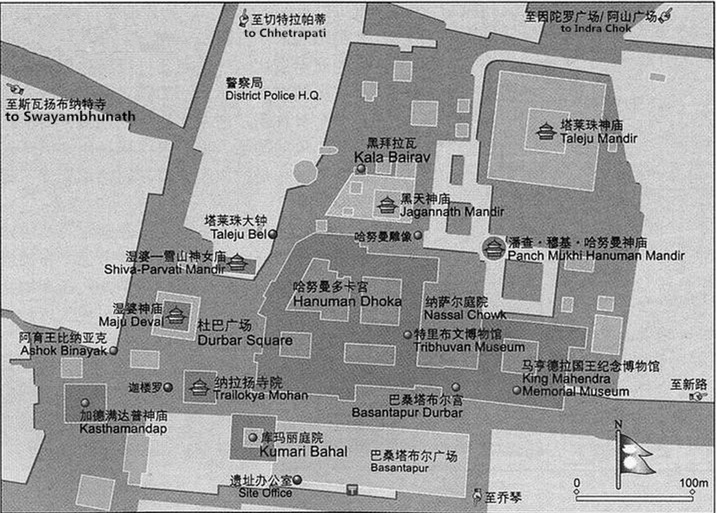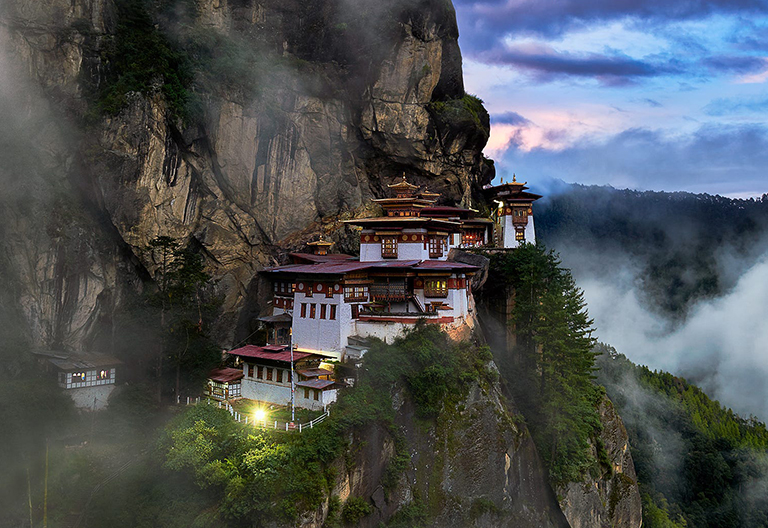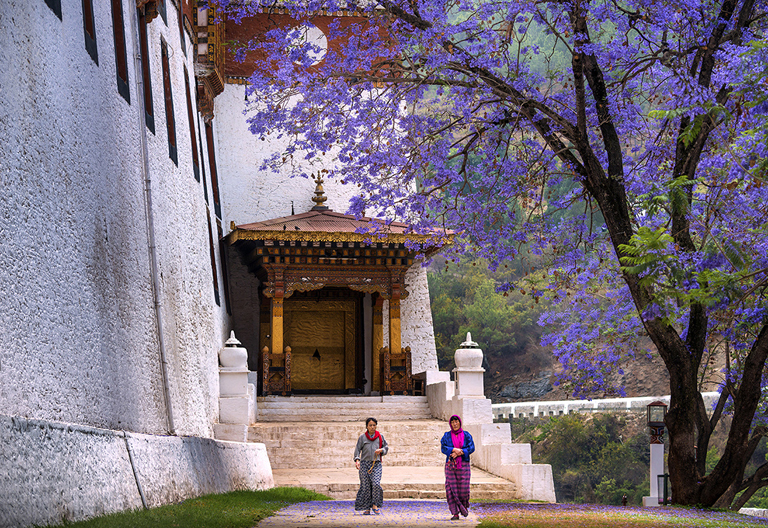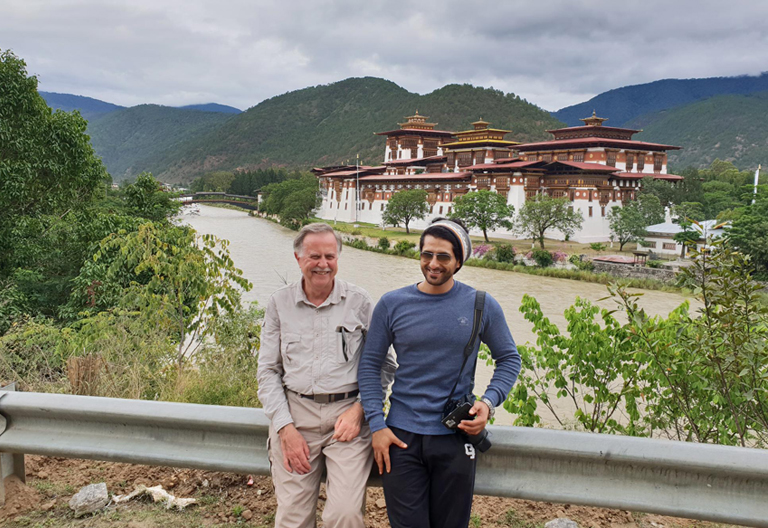
Kathmandu Durbar Square
Kathmandu Durbar Square - the uppermost and best-known attraction in Kathmandu lies in old town of Kathmandu, in front of the former royal palace. It is one of the three Durbar Squares in Kathmandu Valley listed as UNESCO World Heritage Sites. As a cluster of classic architectures and over 50 temples, palaces and courtyards which date back to the 12th to 18th centuries, the square maintains its original building style and glamour.
Honored as “the museum of temples”, Kathmandu Durbar Square is the largest concentration of ancient buildings located in the heart of Kathmandu and the greatest achievements of the Malla Dynasty. Exotic and erotic carvings are also can be seen at this part of the region. Kumari Bahal and Maju Deva Shiva Temple are the places where one can see the real Nepal architectures with multicolor engravings on the walls and doors. A few buildings in the square were collapsed due to the damage of Nepal Earthquake on April 25, 2015. China is helping Nepal to restore the Nine-Storeyed Basantapur Tower at Durbar Square of Kathmandu.
☞ 4 Days Classic Kathmandu Valley Tour
☞ 5 Days Kathmandu Pokhara Leisure Tour
Kathmandu Durbar Square Facts
- Ratings:
- Season:
- All Year Round
- Type:
- World Heritage Site, Architecture, Religious Site
- Altitudes:
- 1370 meters
- Location:
- center of Kathmandu City, Nepal
How to Get to Kathmandu Durbar Square
Kathmandu Durbar Square lies in south central Kathmandu and south of Thamel Street. The Durbar Square is not far, about 20~30 minutes by walking from Thamel Street through some alleys, square and small temples along the way. Or tourists could also take a rickshaw or taxi to get there in several mintues.
Taxi Information for your reference:
● Thamel Street - Kathmandu Durbar Square: about 2km for less than 20 mins' walking
● Tribhuvan Airport - Kathmandu Durbar Square: about 7km for 25mins' driving
● Boudhanath Stupa - Kathmandu Durbar Square: about 8km for 30mins by taxi
● Swayambhunath Temple - Kathmandu Durbar Square: about 3km, 14mins by taxi
● Pashupatinath Temple – Kathmandu Durbar Square: about 6km, 30mins by taxi
Kathmandu Durbar Square History
Durbar means “Palace” in Nepali language, Durbar Square once was the royal palace square of Malla Kings and the subsequent Shah Dynasty in Nepal. The original east palace was built in the middle of 16th century and later the square went through constant extension from Kings of Malla Kingdom.
The Malla Dynasty is the first kingdom ruled Kathmandu Valley from the 13th century to middle 18th century. In 1768, Shah Dynasty - the last monarchy dynasty in Nepal history occupied Kathmandu Valley and built four more observatories in southeast of Durbar Square. All the following kings of Shah Dynasty lived here until they relocated to the new palace in 1886. After the royal family moved to Narayanhiti Palace, all the old palace - Durbar Square was kept as a museum with Kings’ portraits and lots of objects and photographs of King Tribhuvan. Kathmandu Durbar Square was severely damaged due to the Nepal earthquake in 2015, most structures were collapsed, among these, Kasthamandap and Maju Deval have been completely slumped, part of the old royal palace has collapsed and now is a dangerous building.
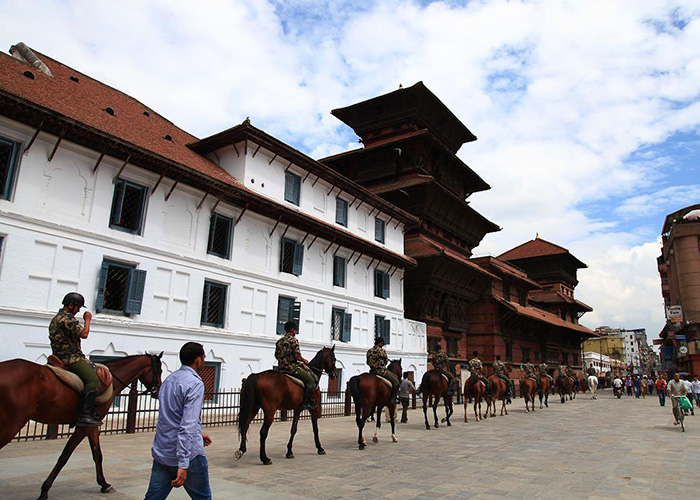
Old Royal Palace in Durbar Square
Highlights in Kathmandu Durbar Square
Durbar Square is actually comprised of 3 distinct scattered temple squares. To the south of the Durbar Square is the Basantapur Square facing north Basantapur Durbar. Western of the Durbar Square, where many temples and famous sites assembled, is the primary area of the square. In the northeastern, it is the sub zone of Durbar Square with an entrance to former palace sites. Makhan Street - an open ground extending to northeast was a major traffic thoroughfares in Kathmandu and now is a very famous pedestrian street. The main scenic spots are Kasthamandap, Ashok Binayak, Kumari Bahal, Trailokya Mohan, Shiva – Parvati Mandir, Hanuman Dhoka (the old royal palace), Talaju Temple and Kala Bairav. Kasthamandap is a good place to start exploring the Durbar Square.
Top Nepal Tours involving the highlights of Kathmandu Durbar Square
☞ 4 Days Classic Kathmandu Valley Tour
☞ 5 Days Kathmandu Pokhara Leisure Tour (by Flight)
☞ 8 Days Nepal Holiday Tour (Kathmandu - Pokhara - Chitwan)
Kasthamandap Temple
Kasthamandap stands for “Kathmandu” in Nepalese. Locals believe the whole Kathmandu City was constructed around Kasthamandap and it’s the origin of the name of Kathmandu City. Regarded as the oldest building in Kathmandu Valley, the temple located in southwest of Durbar Square was built in far 12th century with all wood from one single Shorea Assamica Dyer tree, served as a public house for passing pilgrims and the passerby. It is a three-storey quadrangled pagoda building that is about 20m high. The log cabin at the center of Kasthamandap enshrines a Gorakhnath statue and there are many Ganesh statues and baldachine of other gods in every corner of the yard. Ruined by Nepal earthquake in 2015, Kasthamandap is under repair now. Ashok Binayak Temple with gilded roof is in northern Kasthamandap Temple.
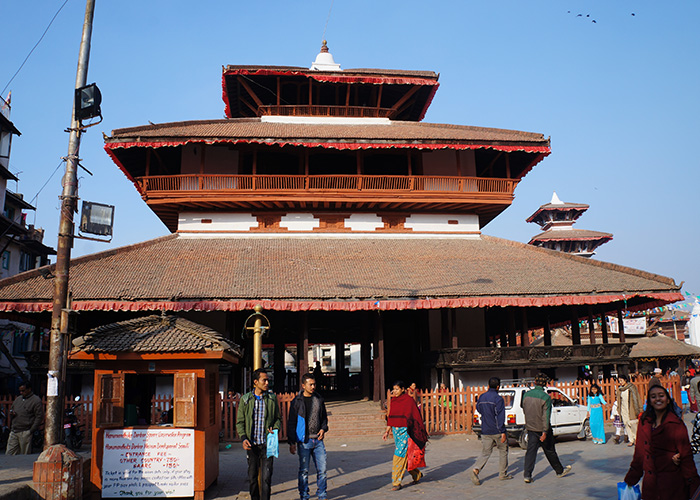
Kasthamandap Temple
Kumari Bahal
Situated in the southern side of the square and east of Kasthamandap, left side of entrance to Durbar Square, Kumari Bahal, one of the must-sees in Kathmandu Durbar Square, is the residence of Kumari - “the Living Goddess” of Nepal. The red brick building of three stories preserved many gorgeous and exquisite woodcarvings like Buddha, peacocks and other pictorial on balcony and windows in the courtyard. Trishna Shakya - a three years old girl, is a specially chosen for she is said to be the human incarnation of the head Hindu goddess. If you are fortunate enough you may see her during one of her public appearances on the third floor for 20~ 30s. Every day groups of visitors queues up to watch her when she shows up. Currently only the first floor is opened for foreign tourists. No photographing is allowed then, but tourists can buy postcards printed with headshot of the goddess in the gate. Trailokya Mohan Narayan Temple lies in northern Kumari Bahal.
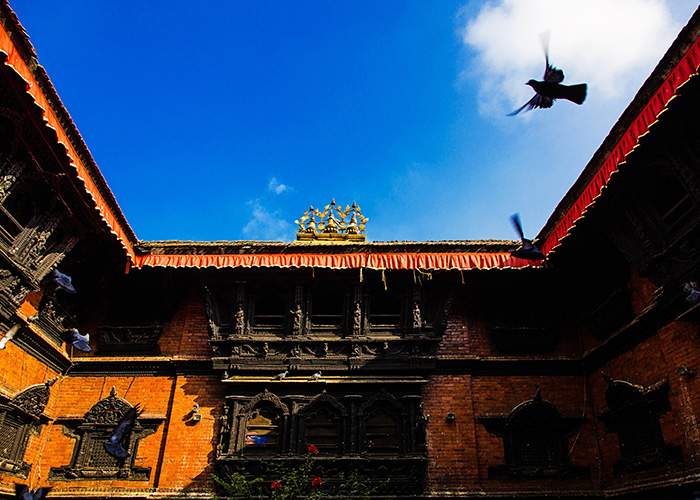
Courtyard of Kumari Bahal
Hanuman Dhoka Durbar
Also called the Old Royal Palace, Haunaman Dhoka in eastern Durbar Square is the largest existing historical sites, which contains the most abundant art collection in Nepal. Hanuman Dhoka means hanuman door, a legend of the brave hanuman punishing the evil and praising the good commended by people. Statues of hanuman stand on the stone pier of left palace gate, covered with a red brocade canopy. The durbar was built in the 13th century initially and consummated mostly in the 17th century; this grand palace has nearly 10 Chowks (palaces) for different purposes.
Foreign tourists are allowed to visit some halls, like the Tribhuvan Museum where you can overlook the whole palace and Durbar Square from the top. Tickets for Hanuman Dhoka is excluded in Durbar Square, should be bought separately. Now this old site is a dangerous building due to the Nepal earthquake.
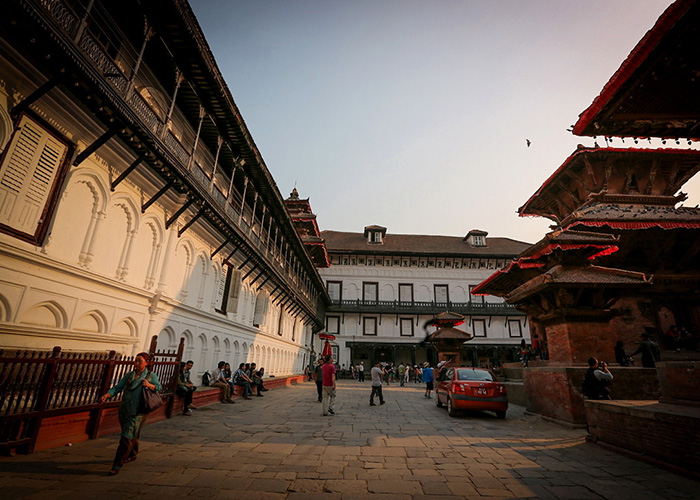
Sunset of Hanuman Dhoka Durbar
Taleju Temple
Built in 1549, Taleju Temple, a three-storeyed gold-plating eave tempio, is the highest temple in Kathmandu with height of about 35m. As the most magnificent architecture in northern Durbar Square, it is constructed on a 12-storeyed square base, having several little temples, stone carvings of lions, monsters and etc. There are entrances on four sides of Taleju Temple, and Taleju Goddess is enshrined in the middle of the lintel of the front door (golden gate) facing south.
Ordinarily it only opened for royal members in the past, now tourist can visit Taleju Temple during Dasain Festival and irregular activities held by the temple to attract visitors.
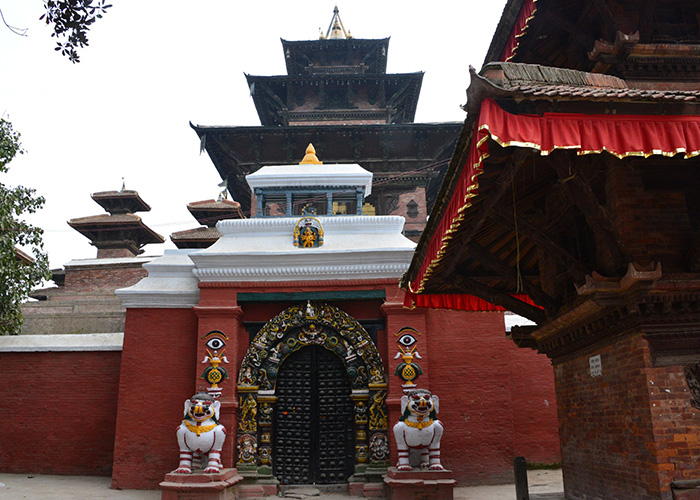
Front Gate of Taleju Temple
Kala Bhairab
Kala Bharab is a giant stone statue of Kala Bhairab (Lord of Terror), one of the reincarnations of Shiva in north of Durbar Square. With a 4~5 meters’ height, Kala Bharab is a grim-looking god holding sword, enemy’s head and dharma-vessels in six arms. It must be the most colorful spot in Durbar Square for lots of people pray in front of the Kala Bhairab in the morning and daub red or yellow pigment on the arms.
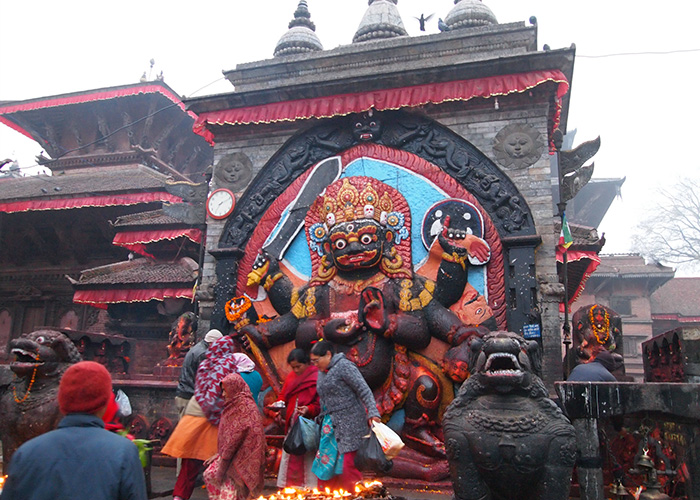
Varicolored Kala Bhairab
Shiva - Parvati Mandir
Next to Maju Deval in the west area, Shiva – Parvati Mandir is a two-storied wooden temple worshiping the Shiva and his wife Parvati. Built by Malla Dynasty, it is now the best repre/div>sentative of landscape architecture of Durbar Square. There are two huge stone lions guarding in the front door and the statues of the couple are right above. Tourists often meet sadhu - look people sitting in front stairs, they will ask for payment if you take group photos with them.
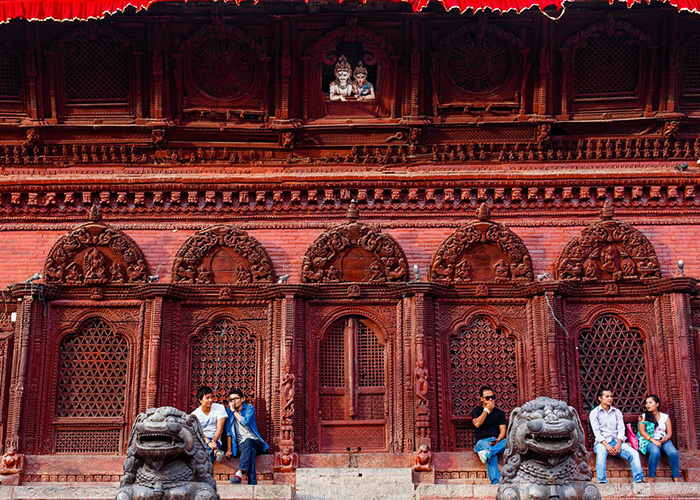
Shiva – Parvati Mandir
Warm Tips for Kathmandu Trip
1. Admission Fee of Kathmandu Durbar Square for foreign visitor is 1,000 Nepalese Rupees (about 10 USD). If necessary, take your passport, ticket and one photo to the Site Office of Basantapur to get a Visitor Pass which allows you visit Kathmandu Durbar Square many times for free.
2. There are many entrances to Durbar Square. You ask help from local Nepalese, other visitors or just follow your Nepal tour guide. Tour around with a professional commentator is a good choice to know the long history and Buddhist culture.
3. Remember to bring personal ID certificates (passports), otherwise tourists will be denied entry the Durbar Suqare.
4. Always be careful when you visit near the dangerous temples. Some buildings were destroyed by the Nepal earthquake, so tourists should take care of yourself and avoid visiting hazardous scenic spots.
How to Plan a Nepal Tour
Best time to visit Nepal: March to mid-June and mid-September to November
How to get to Nepal: overland driving from China (Tibet) and India, flights from China (Tibet, Chengdu…), India (Delhi/Mumbai/Kolkata/Bengaluru...), Bangladesh (Dhaka), Malaysia (Kuala Lumpur), Thailand (Bangkok), Singapore, etc.
Nepal Visa: you can get Nepal Visa on arrival at Kathmandu Airport and border entry ports, or apply for it from Nepal Embassy abroad before departure, which takes about 1 to 3 working days.
Tourists always start a Nepal tour from Kathmandu - the capital city and tourist distribution center. 4 days is enough to enjoy the world heritage sites and Himalayan views in Kathmandu Valley (Kathmandu, Patan, Bhaktapur and Nagarkot). For those travelers who won’t want to miss the most astonishing nature of Nepal, spend 1 or 2 more days visiting lakeside Pokhara. For more experience, Chitwan is a good choice to offer Nepal’s oldest wildlife (various mammal and birds species) as well as a variety of excursions in 2 days usually. If you are a Buddhist follower or fan, travel Lumbini and other Buddhist sites in 3~4 more days. If you are a trekking enthusiast, there is a bucket of trekking routes, like Everest Base Camp Trek, Annapurna Circuit, Poon Hill, etc.
☞ 4 Days Classic Kathmandu Valley Tour
☞ 5 Days Kathmandu Pokhara Leisure Tour (by Flight)
☞ 8 Days Nepal Holiday Tour (Kathmandu - Pokhara - Chitwan)
Travel with Us
Traveling with Himalayas Discovery, you are assured to use our high-quality travel services, including vehicles, professional tour guide and experienced driver, well-organized itinerary, assistance of visa and permits application and other travel related services. We will settle all arrangements in advance to make sure you always enjoy a worry-free journey.
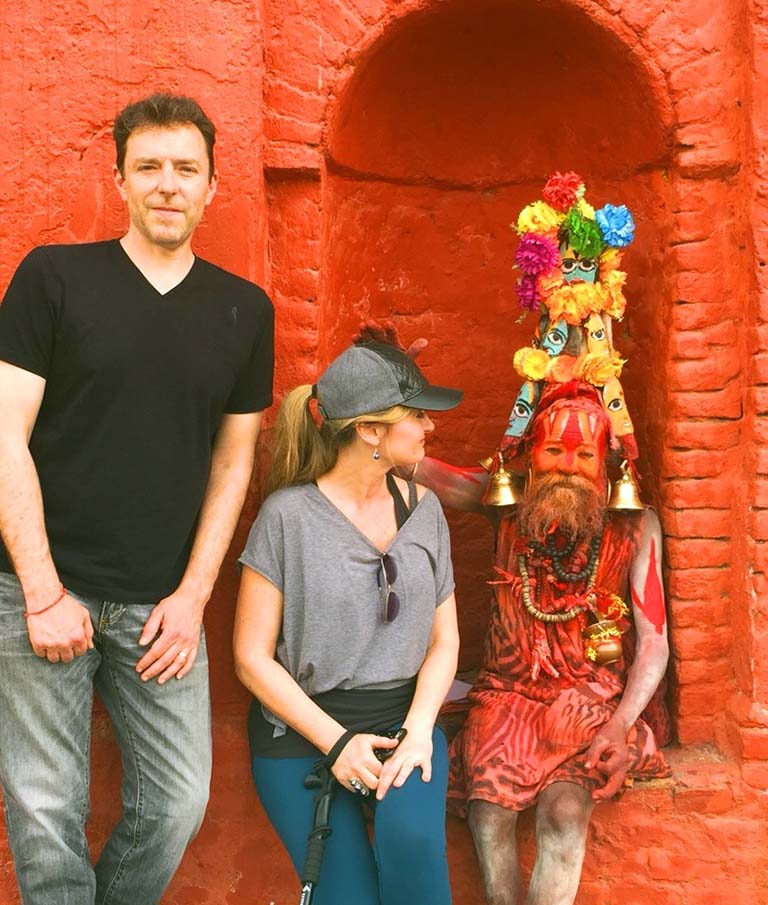
Adam's Family from USA visited Kathmandu with Himalayas Discovery
Kathmandu Travel Guide
Nepal Travel Guide
Recommended Nepal Tour Packages with Kathmandu Durbar Square
Following are 3 most recommended Nepal tour packages that you may be interested in. All tour packages are customizable to meet your personal requirements. You can also contact us to customize a trip if you want.
-

-

-

9 Days Bhutan In-depth Natural and Cultural Tour
Paro / Thimphu / Punakha / Phobjikha / Trongsa / Bumthang / Wangue Phodrang / Paro

